Gifts and Perils of Landslides
By Kenneth Hewitt
Catastrophic rockslides and related landscape developments are an integral part of human settlement along upper Indus streams
Catastrophic rockslides and related landscape developments are an integral part of human settlement along upper Indus streams

DOI: 10.1511/2010.86.410
Large rockslides and the rock avalanches they can generate will destroy any living thing or built structure in their path. In mountain valleys they can form dams impounding lakes that may burst suddenly with devastating consequences.
The January 4, 2010, Atabad landslide, which dammed the Hunza River about 70 kilometers north of Gilgit, Pakistan, offers a stark reminder (see sidebar, below). Not surprisingly, the hazards of landslides have tended to drive scientific study. Less often noted is how they also create resources and opportunities for mountain people.
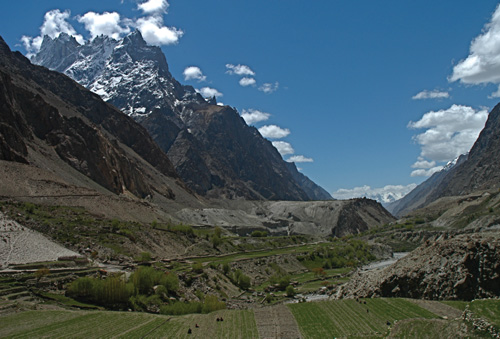
Photograph courtesy of Kenneth Hewitt.
Recently, more than 340 large landslides have been identified along the Indus streams in the Karakoram, Hindu Kush and northwest Himalayan ranges. Most predate historical records but continue to influence landscape developments. Land use is closely adapted to landforms controlled by the landslides. Many villages and some small towns sit amid landslide rubble, as do ancient cultural sites, modern roads, airfields and tourist facilities. The environmental knowledge and stories of local people reveal an understanding of these events, and the geohazards they present.
The landslide-related benefits are notable because so much of the region is inhospitable. Two-thirds of the upper Indus basin lies above 3,500 meters elevation in climates too severe for permanent settlement. Glaciers cover 20,000 square kilometers and permafrost an even larger area. Rain-shadowed valley floors tend to be arid or semi-arid whereas, high above, snowfall is heavy. Precipitous rock walls are the dominant landform. The landslides themselves reflect this rugged terrain, the mountain-building forces at work and valleys deeply excavated in recent geological time. Indeed, where rivers are cutting down vigorously into bedrock to match high rates of tectonic uplift, life has very few and precarious footholds.
Surprisingly, however, most sections of the upper Indus streams flow not in bedrock, but over thick and extensive valley fill sediments. Scientific observers have long been impressed and puzzled by so much deposition within rugged mountains. They realized that the deposits must record events that overwhelm or interrupt stream incision, causing sedimentation along the valleys. Until recently, however, very few of the landslides were identified as such, and their role went unrecognized. Here I will focus on how the rivers are responding to the many landslides that have blocked valleys. I will also describe for the first time the positive effect on the availability of habitable land. Although the article outlines the science behind the discovery and nature of the landslides to introduce their place in settlement geography, we will remain mindful of the major disaster risks that accompany them.
A particular class of landslides dominates the Karakoram—events that combine catastrophic rock slope failure and rock avalanches. They are catastrophic in having sudden occurrence, great size and high speed. They are restricted mainly to the world’s more rugged mountains, because they require large collapses on steep rock walls and a descent of hundreds of meters. Average volume for the Karakoram events is around 200 million cubic meters; at least 32 rank as megaslides (more than a cubic kilometer), and the largest exceed 40 cubic kilometers. The crushing forces involved are so great that, in less than a minute, huge volumes of solid bedrock are reduced to rubble, sand and dust. This transforms the collapsing mass into a rock avalanche—a high speed run out of broken and crushed rock that appears to flow, plunge and surge forward, creating immense dust clouds like the more familiar snow avalanches. Their velocity generally exceeds 100 kilometers per hour and may reach 250 kilometers per hour. When movement falls below such high speeds flow halts abruptly, but within two or three minutes, large areas are buried by rubble and dust.
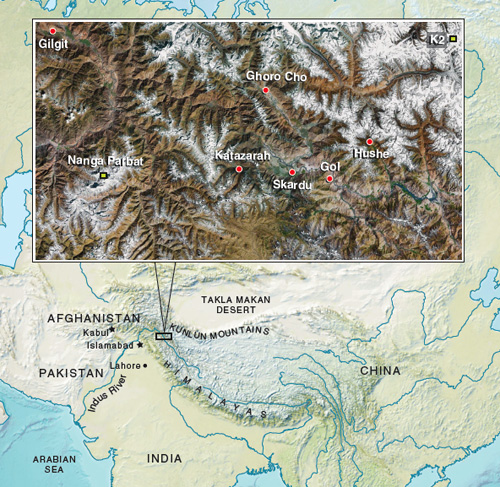
Illustration by Tom Dunne.
The fresh or undisturbed rock avalanche surface usually consists of large boulders. However, in the main body of material, revealed where erosion cuts through, a dense matrix of crushed and pulverized rock envelops the larger clasts. On relatively open and level valley floors the debris spreads to a sheet a few meters thick, lobate in plan and with only minor surface irregularities. However, in the rugged terrain of the Karakoram, local topography complicates matters. Rock avalanches traveling directly across a valley may stall against the opposing wall and remain very thick. The fast-moving debris can climb 500 meters or more up opposing slopes. When moving down narrow canyons it responds to curves and valley-side spurs by swinging from side to side or rising and falling in caroming flow. At valley junctions the debris can split, sending separate lobes far up or down the valleys, or blocking tributaries. A great diversity of plan forms and surface features results (see figure 5).
These landslides are short-lived events, rare on human time scales or at any one location. Their detachment scars on rock walls and masses of debris below, however, can survive and influence landscape developments for millennia. Rock avalanches that travel across river valleys will usually dam them. Unstable, short-lived dams and floods from sudden breaching are of singular concern, but along the Indus streams remnants of lake bed deposits record dozens of former landslide impoundments that lasted decades or centuries. More than 150 landslide barriers remain incompletely cut through today, continuing to act as local base levels for valley development. Their composition, and the shock of the sudden halting of the rock avalanche, make for a highly compacted mass, able to form strong, impermeable landslide dams. Where stalled against opposing slopes, barriers can be hundreds of meters high, and debris lobes spreading far up and down valleys resist erosion and add strength to the dam.
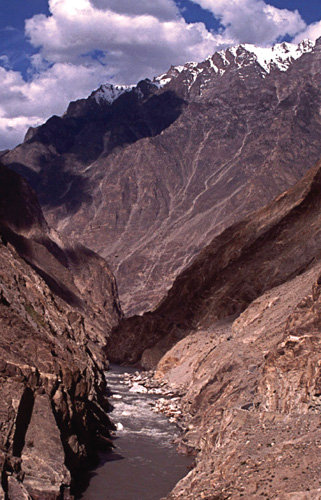
Photograph courtesy of Kenneth Hewitt.
When landslides interrupt streams two interdependent episodes follow. At first sediment is trapped above the dam, the aggradation phase. This continues until breaching occurs bringing the second, degradation phase, as impounded sediments are trenched and removed. It sounds straightforward but both phases are complex, owing partly to diverse landslide configurations and partly to the response of high energy mountain processes. Lake sediments are mainly thin layers of fine-grained material: clay, silt and sand washed into the lake and settling out slowly. Coarser material is dumped quickly around the shores. Streams build deltas or alluvial fans. The latter, an important landform first named from this region by Frederick Drew (1872), is typical where tributaries enter landslide-interrupted valleys. The larger ones, several kilometers across, usually comprise a mix of stream, torrent and debris flow materials. Smaller, steeper ones are built mainly by debris flows. Aggradation in the landslide interruption produces complex buildups with interfingering and overlapping of many different sediments.
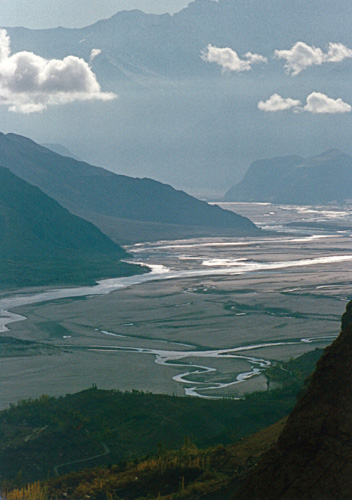
Photograph courtesy of Kenneth Hewitt.
In the degradation phase, systems of stream terraces develop as rivers incise into the sediment pile. Terrace sequences relate to dam history, whereas their slope, width and other properties differ in up-valley sediments compared to those through the landslide and in downstream areas. Tributary channels become incised in the fans, whose outer parts are truncated by the main stream. Rock avalanche and debris fan materials, or bedrock outcrops, create “defended” terraces whose geometry reflects the locations of resistant materials. Because rivers crossing the landslide interruption need not follow the pre-landslide course, they are let down on bedrock spurs or in new valley floor sections and may cut secondary or “epigenetic” gorges, the most common type of bedrock gorge in the region. Such complications, once recognized, help distinguish landslide-generated terraces, fans and canyons from features where sediment transport and stream incision respond directly to climate and hydrological changes, or tectonics.
On average, one cross-valley rock avalanche was found for every 12 to 14 kilometers of upper Indus streams surveyed. The landslide interruptions are encountered in every possible stage of development, depending on age, size and local conditions. Each case is affected by others, some older and some younger. Intact dams upstream will starve downstream impoundments of sediment. Stream flows are moderated by passing through a lake or over flatter, aggraded areas above dams. Conversely, degrading interruptions can send huge pulses of sediment down the valley. Since there are many overlapping sequences of aggradation and degradation from landslide interruptions in different stages of development, they modify and complicate sediment delivery throughout the river system.
Ghoro Cho (“heap of great stones”) comprises a series of boulder-covered ridges across the floor of Shigar Valley (see Figures 6 and 8). Early in my investigations, I stayed there in the shepherds’ hut at Kor-Kor-Tsok-Boo. One evening, having heard of my interest, Apo (grandfather) Haji Ali elected to tell me the “real” story of the great stones. It was after supper and we sat around the open fire, the animals milked and settling down in the corrals, Haji Ali’s face alternately lit by the flames or obscured by the smoke.
Long ago, he said, where Ghoro Cho now lies there was a great and prosperous city. A traveling holy man came there and asked the ruler, the Rajah, for food and shelter. He was turned away, and by other wealthy folk. At last a poor woman gave him shelter and shared her food. Next morning he told her to climb to some springs high above the valley floor. He went to the opposite side and smote the rock with his staff. A great part of the mountain came down, burying the city, its wealth and pride.
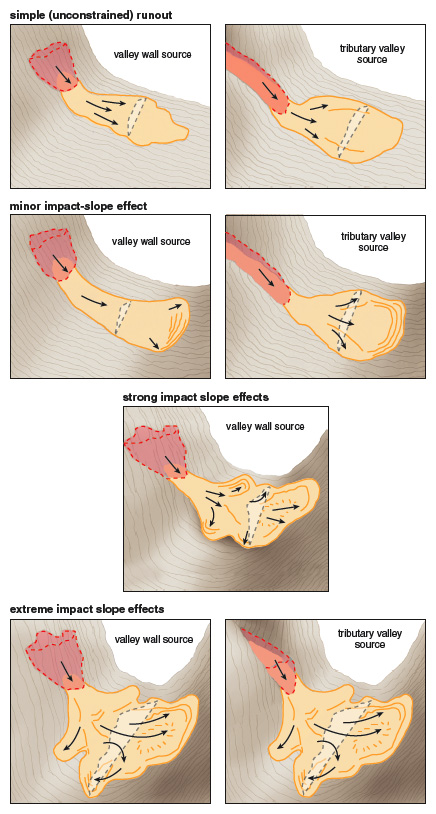
Illustration by Tom Dunne.
Haji Ali’s story resembles morality tales about disasters in many places, including other Karakoram landslides. It may seem more myth than fact. Yet the details are singular, and whoever crafted the story was a fair geologist or landscape detective. Next morning the storyteller walked with me, pointing out the huge scar on the mountain side struck by holy man. Opposite, he identified Mango village and its springs where the old woman remained safe above the cataclysm. He showed me many features among the boulders of Ghoro Cho that proved valuable in reconstructing its geological as well as human story. Visiting the scar on the mountain side, I found green crystalline bedrock identical to Ghoro Cho boulders. Just 100 meters below Mango village, I found the outermost boulders and tell-tale greenish deposits marking the landslide rim.
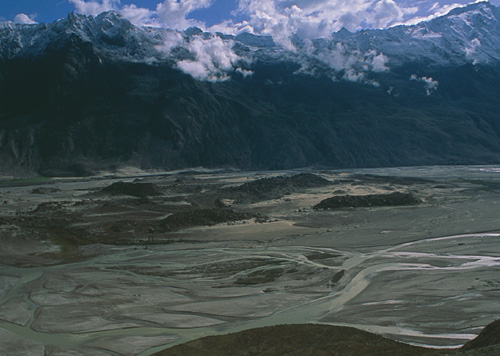
Photograph courtesy of Kenneth Hewitt.
However, this is also important in relation to another story—one from modern geoscience. For over a century Ghoro Cho was interpreted by earth scientists as moraine: debris dumped by glaciers during the Ice Age. I had passed it many times assuming the ridges were moraines, an easy mistake to make. But Haji Ali had the answer to definitively separate landslides from moraines—through rock type. The boulders and other visible fragments of Ghoro Cho are 100 percent that green crystalline rock of the source slope. Major mineral and major element analyses of samples showed that even the finest dust is of identical composition. Glaciers had indeed flowed into the valley, but carried quite different rock types, and of great variety—much as the rivers do today. Meanwhile, rock avalanche particles, from smallest to largest, have the tell-tale angular or “chink stone” character of fractured and crushed material. Moraines of large glaciers have diverse particle shapes including stones rounded in meltwater streams.
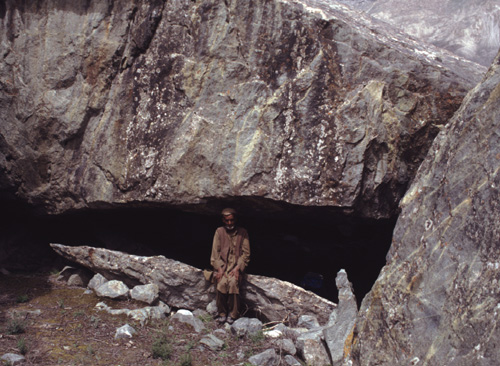
Photograph courtesy of Kenneth Hewitt.
Of course, rock type analysis is bread-and-butter for any trained geoscientist, particle shape for the sedimentologist, but in this case, no one thought it necessary to check them out. The most influential studies from the 1850s to the 1980s offered compelling interpretations of Ghoro Cho as glacial. Indeed, Quaternary geologists believed these and some other landslide deposits represented the same three or four Ice Age glaciations described around the European Alps and in Scandinavia. The author of Haji Ali’s story knew better, but the moraine hypothesis prevailed until the 1990s.
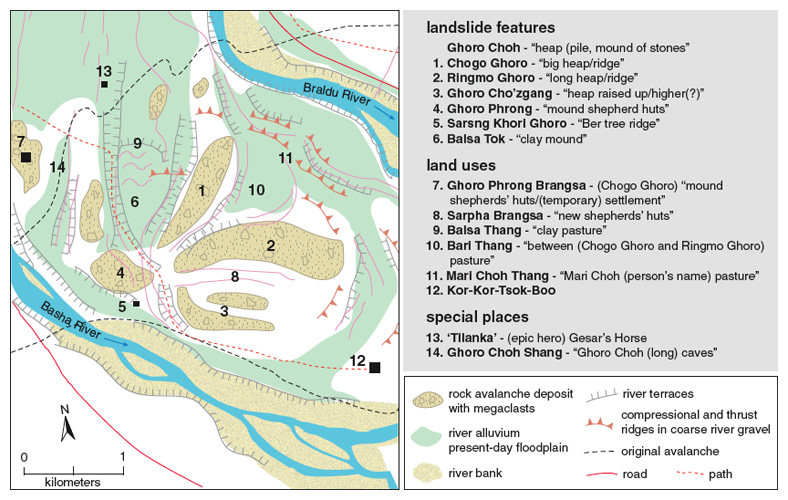
Illustration by Tom Dunne.
Ghoro Cho can be a formidable place, dark and forbidding from a distance, mostly barren and swept daily by dust storms. Yet, every square inch is known to local people. Too far from water for cultivation, the area serves mainly as grazing land. Troglodyte homes for shepherd families and their animals lie under the largest boulders, and the residents have names for every feature. Many other stories are told, recalling the wolves, bears and Siberian tigers that once sought refuge among the boulders; dangerous djinns or “fairies”; and heroes from the Kesar Saga, the great oral epic of Shigar valley. Among these narratives are solid grains of empirical and practical truth, useful as environmental knowledge or contributing to a sense of place, history and calamity.
The village of Gol on the Indus is a typical oasis of human-made greenery amid bare rock walls, closely adapted to features developed after a landslide descended from nearby mountain walls. In fact, debris from two megaslides blocks the Indus here for 11 kilometers. Most of the way it forms barren, boulder-covered terrain used, much like Ghoro Cho, for seasonal grazing and hunting, and where shepherds gather great bales of Artemesia for kindling. Gol itself is on a rock avalanche lobe that travelled 5 to 6 kilometers up the valley. Boulder-covered mounds support homes and schools, the mosque and dispensary. Arable land sits on flats between, once the floor of the landslide lake. It was 500 meters deep at Gol and at least 90 kilometers long. Farms and fields are also scattered over river terraces recording the sequence of incision by the river.
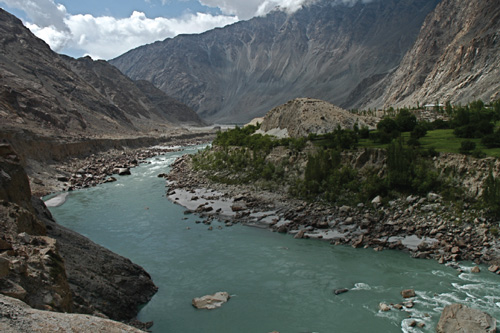
Photograph courtesy of Kenneth Hewitt.
Of course, the hands of local farmers and their wives have made the terraced fields, fertile soil and channels to carry irrigation water. Stone from the landslide is used for terracing and other construction, broken from boulders left conveniently on the valley floor. The villagers at Gol have their stories too, telling of a former lake and boats tied up at places far above today’s river; of the cataclysm that created the lake; and of a flood from up-valley that destroyed it. I suspect this also reflects an eye for landscape more than remembered history. At least, our age determinations put the landslide at 4,300 years ago (+/-170 years)—long before permanent settlement!
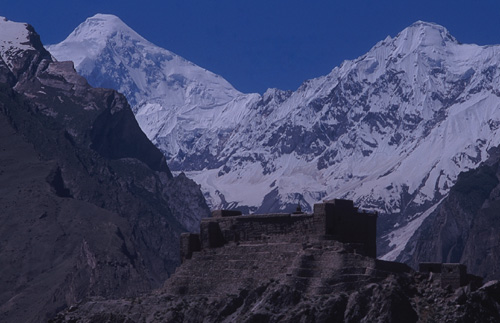
Photograph courtesy of Kenneth Hewitt.
Many villages like Gol occupy landforms developed through landslide interruptions. Skardu and Khapalu, the main towns of Baltistan, are spread over rock avalanche areas. At Skardu and Gilgit the airports lie on terrace levels related to former landslide dams. Taxiing from the runway at Skardu you pass bluffs in fine-grained yellow sediments laid down in a vast lake dammed by the landslide at Katzarah. One can only marvel at the extraordinary range of resources and uses people have found for the landslides.
Some of the earliest records of human presence, rock carvings and inscriptions, are found on rock avalanche boulders or outcrops polished by the rivers cutting through them. This includes Ghoro Cho and Gol. It seems that indigenous peoples and ancient travelers identified these as special localities, often as sacred places. The greatest concentration of petroglyphs, possibly up to 5,000 years old, lies between Rakhiot Bridge and Shatial along the Indus River below Nanga Parbat (8,129 meters in elevation). Perhaps there are exceptional numbers of suitable sites, or the landscape inspired a special awe in early residents and travelers. Either way, every part of the Indus valley here is shaped by large landslides and their interruption cycles. Thanks to them, land suitable for cultivation supports quite heavy settlement today, although plans for a major hydroelectric dam would drown much of it and the petroglyphs. Proponents evidently are unconcerned by the danger of great landslides!
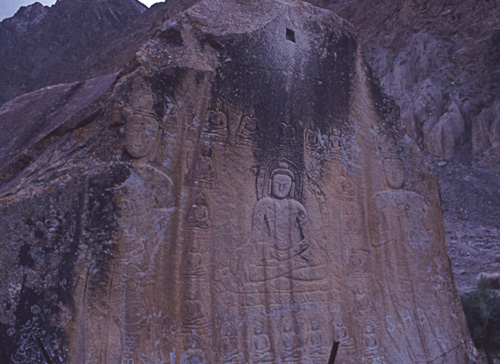
Photograph courtesy of Kenneth Hewitt.
From the 1st to the 10th century A.D., Buddhist pilgrims traveling between the subcontinent, China or Tibet followed the Karakoram Indus valleys, and marked the way with images of the Buddha, stupas, hand prints and inscriptions. Best known, perhaps, are carvings and inscriptions immediately south of Skardu—on a boulder of the landslide that dammed Satpara Lake.
Another famous site, the Sacred Rock of Hunza, is covered in pre-, and post-Buddhist petroglyphs spanning thousands of years. It is located where a 1.5 cubic kilometer rock avalanche descended from the walls of Ultar Glacier. Sediments, formed in the lake it impounded, are quarried at the “Pakistan-China” brick factory, just upstream of the Sacred Rock. When the river was let down on the rock spur below Altit Fort, it cut a rock gorge, leaving a mid-valley salient, the Sacred Rock, between this and the pre-landslide channel. Some 500 meters up the slope above, the rock avalanche provides the foundations of Baltit palace, thought to be over 700 years old and recently restored as a World Heritage Site. In general, the classic landscapes of Hunza are adapted to features controlled by this and other landslides—the countless terraces, the fruit tree blossoms of spring, bright green crops in summer and orange expanses of apricots in Fall.
Nowadays the Sacred Rock is reached along the Karakoram Highway (KKH) linking Pakistan and China. It follows gorges cut through the Nanga Parbat and Karakoram Ranges, and the roadbed lies over terraces and fans generated by landslide interruptions. Bridging points exploit narrows and foundations they have created. Over the 275 kilometers from Sazin to Sost, KKH crosses more than 40 catastrophic landslides. Some sections where collapses or blockages happen repeatedly are excavated through old landslide deposits.
The gravest hazards arise at the time of the landslides and later if landslide dams collapse releasing sudden floods. The greatest historical floods on the upper Indus came from short-lived landslide dams in 1841 and 1858. Temporary losses arose when the lakes inundated settlements and severed communications, as again above Atabad in 2010.
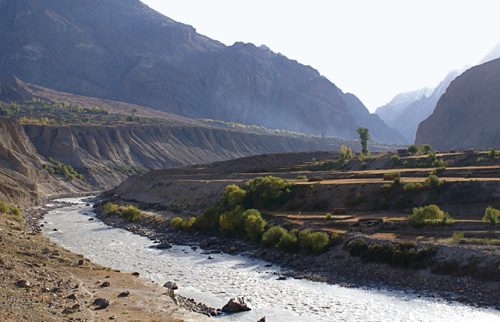
Photograph courtesy of Kenneth Hewitt.
Yet landslide-related hazards are not confined to these short-lived extremes. The aggradation phase can become increasingly hazardous. As sediment builds up in channels the more frequent regional hazards—debris flows, rainstorm and glacier-melt floods—will change paths across fans and deltas, threatening arable land and even village sites. Degraded interruption complexes tend to be safer because old lake bed, terrace and fan surfaces sit well above incised channels down which floods and debris flows travel. Even so, rock avalanche material mobilized by heavy rains or flood scour can feed damaging debris flows, as happened at Gol in 1996. Fields were left buried in rubble, and boulders acted like battering rams destroying walls and homes.
Local communities do observe strategies to reduce or prevent harm from these more common mountain hazards through land use, watching places or weather conditions that are dangerous, or coming together to repair property after a damaging event. However, the landslides themselves are dangers of a quite different order. The evidence outlined here raises singularly disturbing questions about what triggers them, and the marked disparity between their prehistoric and historical numbers.
Because nearly all 340-plus rock avalanches affecting the rivers descended across ice-free valleys, they post-date the last major glaciation (LMG). This brackets the time frame involved and, if the LMG here followed the most common Northern Hemisphere pattern, these valleys became ice-free about 12,500 to 10,000 years ago. The 11 events with numerically-determined ages, and some 30 related to them through the sedimentation record, happened between 2,000 and 8,000 years ago. Some temporal clustering of events is indicated, but there is no clear decrease (or increase) in incidence over the period. In geological, rather than human terms, the landslides are very young. Meanwhile, surveys to date cover barely 25 percent of the basin. If these are at all representative, four times as many may yet be discovered over a mountainous area of about 100,000 square kilometers. The record of recent centuries offers no precedent for their numbers, or their magnitudes.
Immediate triggers of large landslides are usually earthquakes or weather extremes. Stormy weather has been associated with several cases, but larger Karakoram events seem too deep-seated. They were most likely co-seismic. The 1841 landslides were triggered by an earthquake, and instabilities leading to the 2010 event are traced to a 2002 earthquake. However, these and the 1858 event, though very destructive, are among the smaller rock avalanches; one reason their dams failed so quickly! Many prehistoric examples are one to three orders of magnitude larger, and seem to require equally powerful earthquakes.
Another puzzling fact, however, is that the Karakoram appears relatively “quiet” seismically. Modern records for the Skardu-Shigar basins show only minor, scattered seismic sources, although some 16 massive rock slope failures are known, including 3 megaslides. Most are younger than about 8,000 years, and at least 9 are between 4,000 and 2,000 years old. How, therefore, do we explain the larger landslides—and so many more occurring prior to historical records? Larger earthquakes seem required even than those that caused major disasters in surrounding areas, such as at Quetta in 1935 (magnitude 7.7) or Kashmir in 2005 (magnitude 7.6).
The landslides evidence seems increasingly to support the hypothesis of Peter Molnar, Roger Bilham and others about missing great Himalayan earthquakes. To bring surface strain features into conformity with plate tectonic stresses would, apparently, require intermittent megaearthquakes (magnitude 8 or 9). Their near absence from written records suggests they recur on very long intervals—500 to 1,000 years at least—implying equivalent “seismic gaps” in time and space across the Himalayan arc. The northwest Himalaya, according to seismic and geodetic studies, seem overdue for a mega-earthquake—what Californians call “the Big One.”
If the larger landslides are indeed triggered by megaearthquakes, it means that rare, seismo-tectonic events punctuate, reset and, ultimately, control the landscape agenda. The landslide-related features along the Indus streams support such a view. They comprise indirect and drawn-out, post-landslide responses, or “relaxation” phases, following landslide shocks. They develop on millennial time scales and, coincidentally, create conditions favorable to generations of human habitation.
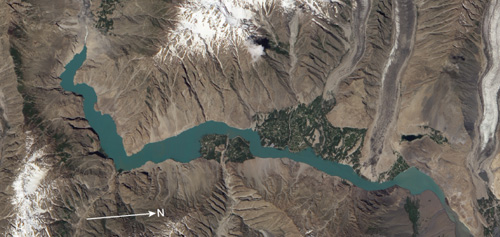
On January 4, 2010, a rockslide swept away part of the village of Atabad in the Hunza Valley of northern Pakistan (upper left of photograph below). Seventeen people were killed and twenty-six homes were destroyed. The slide also blocked the Hunza River, creating a lake that inundated several other villages and submerged three miles of the Karakoram Highway.
By July 7, the date of this image taken by the Advanced Land Imager on NASA’s Earth Observing-1 satellite, the lake was nearly 22 kilometers long and about 115 meters deep, had displaced about 250 households, and had cut off from the outside world roughly 25,000 people located in valleys above the lake.
The “worst case” disaster would be for the dam to fail catastrophically, sending a great flood wave downstream threatening land, settlements and infrastructure. To be safe, the government has resettled about 20,000 people downstream in temporary camps above the likely catastrophic flood height. Meanwhile, workers began digging a spillway in the dam by late January, but the going was slow, the reduction in dam height modest. However, the dam did not erode quicky when the lake finally overflowed in late May, and since early July the lake level has stabilized. The spillway stream from the lake can be seen as a white line in the upper left of the image.
Unfortunately, if the dam continues to hold, it still presents considerable, if less extreme, concerns. Decisions must be made about the displaced residents, as well as the relocation of the Karakoram Highway. There are also strong pressures to lower the dam, which would be costly and require great care to be done safely. The crisis is far from over.
More sobering, however, are the rare but cataclysmic hazards implied: events that combine great earthquakes with multiple large landslides, river valleys inundated above, and starved of sediment and water below, for centuries at least. And no capacity presently exists to predict, let alone prevent, events on such scales. Certainly, more could and should be done to adopt and enforce higher levels of structural safety for buildings, which could at least save lives away from megaearthquake epicenters and landslide run-out zones. Regional preparedness, if more effective than in recent earthquake disasters, could improve survival and recovery possibilities. For the moment, however, expanding towns and cities, along with large-scale infrastructure, notably big dams and highways, are increasing the concentrations of people and structures at risk.
Through most of history land use in the Himalaya was organized around widely scattered villages and smallish centers. Today, such an approach is commonly treated as outmoded—a less efficient form of existence—and in many cases traditional risk-averting arrangements and environmental knowledge are being undermined or lost. On the other hand, the inhabitants may carry a deep structure of historical understanding about collective security for living with a catastrophically generated land base. Their landslide stories may be more realistic than fatalistic in coming to terms with such an environment.
Finally, although the Karakoram has exceptional numbers, landslides and landslide-related developments clearly exist in other mountains. Examples are known, and the list grows rapidly, throughout High Asia, in the western cordilleras of the Americas, the European and New Zealand Alps, and the Caucasus. In some of these, too, indications of rare megaearthquakes are being investigated. The situation supports calls for a revised concept of the drivers of landform development in high mountains, and a rethinking of responses to the geohazards involved.
Click "American Scientist" to access home page
American Scientist Comments and Discussion
To discuss our articles or comment on them, please share them and tag American Scientist on social media platforms. Here are links to our profiles on Twitter, Facebook, and LinkedIn.
If we re-share your post, we will moderate comments/discussion following our comments policy.